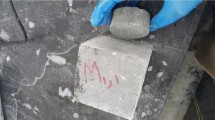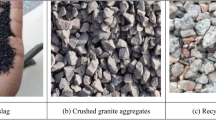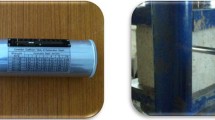Abstract
The study proposes a new model for estimating the compressive strength of high-strength concrete using destructive and non-destructive testing. The effect of silica fume replacement level and its cementing efficiency factor on compressive strength and ultrasonic pulse velocity (UPV) were experimentally examined. In the present work, the cementing efficiency factor (k) for silica fume at different percentage replacement level has been assumed, and at the constant water-to-binder ratio, the compressive strength has been obtained. An exponential relationship is proposed between UPV and compressive strength with a high correlation coefficient. A statistically noteworthy model with a high correlation coefficient R2 > 0.90 is established to study the influence of the variables (%SF and k) on UPV results. Finally, the two proposed models were amalgamated to develop a new model to predict the 28-day compressive strength of high-strength concrete. The validity of the model has been verified with the results obtained by different researchers on different types of specimens. The proposed new model is for the strength range of the 40–75 MPa.











Similar content being viewed by others
References
ACI Committee 318 (1995) Building code requirements for structural concrete (ACI 318-95) and commentary (ACI 318R-95). Am Concr Inst 552:503
C. CEB-FIP, Model Code 1990, Com. Euro-International Du Beton, Paris. (1991) 87–109. https://doi.org/10.1680/ceb-fipmc1990.35430
Shen D, Wen C, Zhu P, Wu Y, Yuan J (2020) Influence of Barchip fiber on early-age autogenous shrinkage of high strength concrete. Constr Build Mater. https://doi.org/10.1016/j.conbuildmat.2020.119223
Shen D, Li C, Feng Z, Wen C, Ojha B (2019) Influence of strain rate on bond behavior of concrete members reinforced with basalt fiber-reinforced polymer rebars. Constr Build Mater. https://doi.org/10.1016/j.conbuildmat.2019.116755
Shen D, Wen C, Zhu P, Li M, Ojha B, Li C (2020) Bond behavior between basalt fiber-reinforced polymer bars and concrete under cyclic loading. Constr Build Mater. https://doi.org/10.1016/j.conbuildmat.2020.119518
Villar-Cociña E, Rodier L, Savastano H, Lefrán M, Rojas MF (2020) A comparative study on the Pozzolanic activity between bamboo leaves ash and silica fume: kinetic parameters. Waste Biomass Valorization 1–8. https://doi.org/10.1007/s12649-018-00556-y
Sharaky IA, Megahed FA, Seleem MH, Badawy AM (2019) The influence of silica fume, nano silica and mixing method on the strength and durability of concrete. SN Appl Sci 6:575–584. https://doi.org/10.1007/s42452-019-0621-2
Güneyisi E, Gesoǧlu M, Karaoǧlu S, Mermerdaş K (2012) Strength, permeability and shrinkage cracking of silica fume and metakaolin concretes. Constr Build Mater 34:120–130. https://doi.org/10.1016/j.conbuildmat.2012.02.017
Siddique R, Khan MI (2011) Supplementary cementing materials. In: Springer Sci. Business, Media, pp 67–120
Wang F, Li S (2012) Effect of silica fume on workability and water impermeability of concrete. Appl Mech Mater 238:157–160. https://doi.org/10.4028/www.scientific.net/AMM.238.157
Mohan A, Mini KM (2018) Strength and durability studies of SCC incorporating silica fume and ultra fine GGBS. Constr Build Mater 171:919–928. https://doi.org/10.1016/j.conbuildmat.2018.03.186
Khayat KH, Yahia A, Sayed M (2008) Effect of supplementary cementitious materials on rheological properties, bleeding, and strength of structural grout. ACI Mater J 35:842–849. https://doi.org/10.14359/20200
Maage M (1989) Efficiency factors for condensed silica fume in concrete. ACI Spec Publ 114:783–798
Bhanja S, Sengupta B (2002) Investigations on the compressive strength of silica fume concrete using statistical methods. Cem Concr Res 32:1391–1394. https://doi.org/10.1016/S0008-8846(02)00787-1
Albattat RAI, Jamshidzadeh Z, Alasadi AKR (2020) Assessment of compressive strength and durability of silica fume-based concrete in acidic environment. Innov Infrastruct Solut 5:20. https://doi.org/10.1007/s41062-020-0269-1
Smith IA (1967) The design of fly ash concretes. Proc Inst Civ Eng 36:769–790. https://doi.org/10.1680/iicep.1967.8472
Jahren P (1983) Use of silica fume in concrete. ACI Spec Publ 79:677–694. https://doi.org/10.14359/6715
Sellevold EJ, Radjy FF (1983) Condensed silica fume (Microsilica) in concrete: water demand and strength development. Spec Publ 79:677–694
Gopalan MK, Hague MN (1985) Design of flyash concrete. Cem Concr Res 15:694–702. https://doi.org/10.1016/0008-8846(85)90071-7
Babu KG, Rao GSN (1993) Efficiency of fly ash in concrete. Cem Concr Compos 15:223–229. https://doi.org/10.1016/0958-9465(93)90025-5
Feret R (1892) On the compactness of hydraulic mortars. Memoirs and documents relating to the art of constructions at the service of the engineer. Ann Des Ponts Chaussées. 2nd semest 5–161
Bolomy (1927) Durcissemenr des morriers er betons. Bull Tech Suisse Rom 16–24
Abrams DA (1918) Design of Concrete Mixtures, Bull. No. 1, Struct. Mater. Lab. Lewis Institute, Chicago, p 20
Slanička Š (1991) The influence of condensed silica fume on the concrete strength. Cem Concr Res 21:462–470. https://doi.org/10.1016/0008-8846(91)90094-X
Ganesh Babu K, Surya Prakash PV (1995) Efficiency of silica fume in concrete. Cem Concr Res 25:1273–1283. https://doi.org/10.1016/0008-8846(95)00120-2
Loland K (1981) Silica concrete (Norwegian). In: J Nord Concr Fed
Fagerlund G (1981) Definition of water/cement ratio using silica fume Swedish. In: Intern. Cem Rep
Malathy R, Subramanian K (2007) Efficiency factor for silica fume & metakaoline at various replacement levels. Singapore Concr Inst (2007). http://cipremier.com/100032037%5Cnwww.cipremier.com
Yoshitake I, Inoue S, Miyamoto K (2019) Strength properties of durable concrete made with various alternative. Interdepend Between Struct Eng Constr Manag 1–6
Khan AN, Magar RB, Chore HS (2018) Efficiency factor of supplementary cementitious materials: a state of art. Int J Optim Civ Eng 8:247–253
Li LG, Zheng JY, Ng PL, Zhu J, Kwan AKH (2019) Cementing efficiencies and synergistic roles of silica fume and nano-silica in sulphate and chloride resistance of concrete. Constr Build Mater 223:965–975. https://doi.org/10.1016/j.conbuildmat.2019.07.241
Sharaky IA, Megahed FA, Seleem MH, Badawy AM (2019) The influence of silica fume, nano silica and mixing method on the strength and durability of concrete. SN Appl Sci 1:1–10. https://doi.org/10.1007/s42452-019-0621-2
Pereira N, Romão X (2016) Material strength safety factors for the seismic safety assessment of existing RC buildings. Constr Build Mater 119:319–328. https://doi.org/10.1016/j.conbuildmat.2016.05.055
Breysse D (2012) Nondestructive evaluation of concrete strength: an historical review and a new perspective by combining NDT methods. Constr Build Mater. https://doi.org/10.1016/j.conbuildmat.2011.12.103
Lin Y, Lai CP, Yen T (2003) Prediction of ultrasonic pulse velocity (UPV) in concrete. ACI Mater J 100:21–28. https://doi.org/10.14359/12459
Ju M, Park K, Oh H (2017) Estimation of compressive strength of high strength concrete using non-destructive technique and concrete core strength. Appl Sci. https://doi.org/10.3390/app7121249
Khan SRM, Noorzaei J, Kadir MRA, Waleed AMT, Jaafar MS (2007) UPV method for strength detection of high performance concrete. Struct Surv 25:61–73
Atici U (2011) Prediction of the strength of mineral admixture concrete using multivariable regression analysis and an artificial neural network. Expert Syst Appl. https://doi.org/10.1016/j.eswa.2011.01.156
Najim KB (2017) Strength evaluation of concrete structures using ISonReb linear regression models: laboratory and site (case studies) validation. Constr Build Mater 149:639–647. https://doi.org/10.1016/j.conbuildmat.2017.04.162
Atahan HN, Oktar ON, Tademir MA (2011) Factors determining the correlations between high strength concrete properties. Constr Build Mater. https://doi.org/10.1016/j.conbuildmat.2010.11.005
Qasrawi HY (2000) Concrete strength by combined nondestructive methods simply and reliably predicted. Cem Concr Res. https://doi.org/10.1016/S0008-8846(00)00226-X
IS: 8112 (1989) Ordinary Portland cement, 43 grade-Specification. Bur. Indian Stand., New Delhi
IS:383 (2016) Specification for coarse and fine aggregates from natural sources for concrete. Bur. Indian Stand., New Delhi, India, pp 1–18
IS:516 (2004) Method of tests for strength of concrete. Bur. Indian Stand., New Delhi, India
Biswas R, Rai B (2020) Effect of cementing efficiency factor on the mechanical properties of concrete incorporating silica fume. J Struct Integr Maint 5:190–203. https://doi.org/10.1080/24705314.2020.1765269
IS:10262, IS:10262-2009 (2009) Indian standards recommended Guidelines for concrete mix design. In: Bur. Indian Stand., New Delhi, India
IS: 1199 (1959) Methods of sampling and analysis of concrete. Bur. Indian Stand., New Delhi
IS: 516 (1959) Method of test for strength of concrete. Bur. Indian Stand., New Delhi
IS:13311 (Part-1) (1992) Non-destructuctive testing of concrete- method of testing. Bur. Indian Stand., New Delhi
Khatri RP, Sirivivatnanon V, Gross W (1995) Effect of different supplementary cementitious materials on mechanical properties of high performance concrete. Cem Concr Res 25:209–220. https://doi.org/10.1016/0008-8846(94)00128-L
Mazloom M, Ramezanianpour AA, Brooks JJ (2004) Effect of silica fume on mechanical properties of high-strength concrete. Cem Concr Compos. https://doi.org/10.1016/S0958-9465(03)00017-9
Kovler K, Roussel N (2011) Properties of fresh and hardened concrete. Cem Concr Res. https://doi.org/10.1016/j.cemconres.2011.03.009
Behnood A, Ziari H (2008) Effects of silica fume addition and water to cement ratio on the properties of high-strength concrete after exposure to high temperatures. Cem Concr Compos. https://doi.org/10.1016/j.cemconcomp.2007.06.003
Ismeik M (2009) Effect of mineral admixtures on mechanical properties of high strength concrete made with locally available materials. Jordan J. Civ, Eng
Kadri EH, Duval R (2009) Hydration heat kinetics of concrete with silica fume. Constr Build Mater. https://doi.org/10.1016/j.conbuildmat.2009.06.008
Kashiyani BK, Pitroda J, Shah DBK (2012) A study of utilization aspect of polypropylene fibre for making value added concrete. Int J Sci Res 2:103–106. https://doi.org/10.15373/22778179/feb2013/37
Alwash M, Breysse D, Sbartaï ZM (2015) Non-destructive strength evaluation of concrete: analysis of some key factors using synthetic simulations. Constr Build Mater. https://doi.org/10.1016/j.conbuildmat.2015.09.023
Alwash M, Sbartaï ZM, Breysse D (2016) Non-destructive assessment of both mean strength and variability of concrete: a new bi-objective approach. Constr Build Mater. https://doi.org/10.1016/j.conbuildmat.2016.03.120
A.I. of Japan (1983) Manual of nondestructive test methods for the evaluation of concrete strength. In: Archit. Inst. Japan Tokyo, Japan
Kim WM, Oh H, Oh KC (2016) Estimating the compressive strength of high-strength concrete using surface rebound value and ultrasonic velocity. J Korea Inst Struct Maint Insp 20:1–9. https://doi.org/10.11112/jksmi.2016.20.2.001
Rashid K, Waqas R (2017) Compressive strength evaluation by non-destructive techniques: an automated approach in construction industry. J Build Eng 12:147–154. https://doi.org/10.1016/j.jobe.2017.05.010
Bungey J (1984) The use of ultrasonics for NDT of concrete. In: Brit J NDT, pp 366–369
Galan A (1990) Combined ultrasound methods of concrete testing. In: North-Holland, Elsevier, Amsterdam
Ismail M, Yusof K, Ibrahim A (1996) A combined ultrasonic method on the estimation of compressive concrete strength. INSIGHT 38:781–785
Pascale GP, Di Leo A, Carli R (2000) Evaluation of actual compressive strength of high strength concrete by NDT. 15th World conf. non-destructive test, 10p. https://www.ndt.net/article/wcndt00/papers/idn527/idn527.htm
Atici U (2010) Prediction of the strength of mineral-addition concrete using regression analysis. Mag Concr Res 62:585–592. https://doi.org/10.1680/macr.2010.62.8.585
Del Río LM, Jiménez A, López F, Rosa FJ, Rufo MM, Paniagua JM (2004) Characterization and hardening of concrete with ultrasonic testing. Ultrasonics 42:527–530. https://doi.org/10.1016/j.ultras.2004.01.053
Mohammed BS, Azmi NJ, Abdullahi M (2011) Evaluation of rubbercrete based on ultrasonic pulse velocity and rebound hammer tests. Constr Build Mater. https://doi.org/10.1016/j.conbuildmat.2010.09.004
Khan MI (2012) Evaluation of non-destructive testing of high strength concrete incorporating supplementary cementitious composites. Resour Conserv Recycl 61:125–129. https://doi.org/10.1016/j.resconrec.2012.01.013
Trtnik G, Kavčič F, Turk G (2009) Prediction of concrete strength using ultrasonic pulse velocity and artificial neural networks. Ultrasonics 49:53–60. https://doi.org/10.1016/j.ultras.2008.05.001
Malhotra V, Carino N (2010) Handbook on nondestructive testing of concrete, 2nd ed. https://doi.org/10.1201/9781420040050
Sorensen EV (1983) Freezing and thawing resistance of condensed silica fume (Microsilica) concrete exposed to deicing chemicals. ACI Spec Publ 79:709–718. https://www.concrete.org/publications/internationalconcreteabstractsportal.aspx?m=details&i=6720
Yamato T, Emoto Y (1989) Chemical resistance of concrete containing condensed silica fume. Spec Publ 114:897–914
Author information
Authors and Affiliations
Corresponding author
Ethics declarations
Conflict of interest
On behalf of all authors, the corresponding author states that there is no conflict of interest.
Rights and permissions
About this article
Cite this article
Biswas, R., Rai, B. & Samui, P. Compressive strength prediction model of high-strength concrete with silica fume by destructive and non-destructive technique. Innov. Infrastruct. Solut. 6, 65 (2021). https://doi.org/10.1007/s41062-020-00447-z
Received:
Accepted:
Published:
DOI: https://doi.org/10.1007/s41062-020-00447-z




